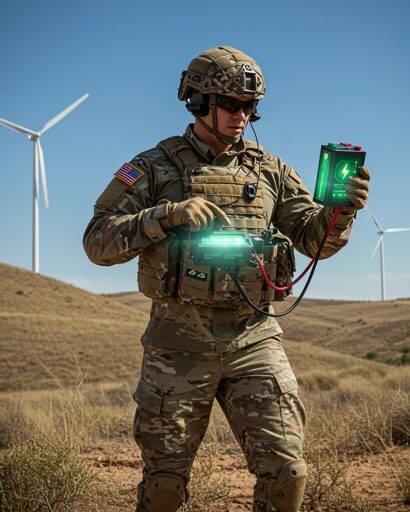Abstract: This paper examines how modern training simulators can aid in teaching future Navy officers. Traditional teaching methods often prioritise classroom learning with limited hands-on practice. This research examines whether the use of realistic simulators can enhance police officers’ learning of their job responsibilities. The study utilises various types of simulators to teach essential Navy skills. These include making quick decisions in battle (using the Tactic simulator), safely navigating (with Navigation and River Navigation simulators), using communication systems (with the GMDSS simulator), using weapons (with Infantry Weapons and Navy Artillery simulators), working in the engine room (using the Engine Room simulator), and practising new experiences using Virtual Reality (VR).
Problem statement: How can simulation technologies be properly used to effectively train future Navy officers?
So what?: The EU should create a database with all simulators available in the EU countries that are related to officers training; the EU should create a guide (and maybe provide funds) to encourage partners to share simulators and knowledge between each other; the EDA should create/choose a protocol of communications between simulators and interconnect simulators or make them available with remote access. All EU member states should combine their efforts to create an EU military with a unique training system.

Source: shutterstock.com/Janwar Fajrin
Introduction
Training and teaching activities are among the most significant aspects of human history. The survival and development of the human race are based on the ability to learn new things and transfer them to the next generations. In the past, the amount of information was relatively small and could be easily learned by a select few. In our days, it is impossible to completely cover only one domain, even for a highly intelligent person. This is why teaching has become a significant challenge. The didactic specialist for every domain must filter and select the right information that a person should receive at different levels of their career. Even then, no one can assure that the selected knowledge, skills and experiences will be the right ones. Only one thing is certain: the world is evolving at a rapid pace, and teaching curricula and methods must be improved at least at the same rate, or even faster, by utilising predictions. Simulators are essential for the race between evolution and training because new technologies can be easily reproduced in a virtual world, even before they are released on the market.
The world is evolving at a rapid pace, and teaching curricula and methods must be improved at least at the same rate, or even faster, by utilising predictions.
State of the Art
Before discussing how to use simulators to train future Navy officers effectively, let us examine the common curriculum subjects used by the world’s major naval powers for training their Naval officers. This research was conducted by studying free and unclassified internet sources.
While the specific structure, emphasis, and duration of training can vary between the naval academies of major powers (like the U.S., UK, Russia, the People’s Republic of China [PRC], India, France, etc.), there is a significant overlap in the core subjects taught to produce competent naval officers. The goal is generally to provide a blend of academic knowledge, technical skills, leadership development, and professional naval competence.
For a structured view of the common core of the curriculum, the information is presented in the following table.
![Common core of the Navy officer curriculum of major naval powers[1-8]](https://tdhj.org/wp-content/uploads/2025/06/Cristea_01.png)
Common core of the Navy officer curriculum of major naval powers[1-8]
The RNA (Romanian Naval Academy) Simulators and Learned Lessons
As it was mentioned, it is impossible to claim to possess the real and only one truth of how to train new navy officers effectively. With hard work and dedication, it is possible to develop an updated curriculum for a Navy officer’s career. This work should also include experience exchange between partners and a thorough examination of technology development and new war strategies and tactics.
This paper presents an example of how the Romanian Navy utilises simulators to transfer knowledge, skills, and competencies to future navy officers. The Romanian Naval Academy utilises a curriculum developed over more than 150 years of experience and aligned with the ESCO classification (European Skills, Competences, Qualifications, and Occupations).[10]
The Romanian Naval Academy utilises a curriculum developed over more than 150 years of experience and aligned with the ESCO classification.
“ESCO works like a dictionary, describing, identifying and classifying professional occupations and skills relevant for the EU labour market and education and training area and systematically showing the relations between those occupations and skills. Its common reference terminology helps make the European labour market more effective and integrated, and allows the worlds of work and education/training to communicate more effectively with each other”.[11]
The Romanian Naval Academy (RNA) in Constanta, like many modern maritime academies, utilises a variety of simulators to provide practical training for its cadets. The simulators are divided into two big categories: for STCW (International Convention on Standards of Training, Certification and Watchkeeping for Seafarers) training and for military training.[12]
Integrated Ship Steering Simulator (ISSS)
To train in Maritime Skills, Technical, and Engineering Subjects, the Romanian Naval Academy has been utilising the Integrated Ship Steering Simulator for over 10 years. It is composed of two major modules, focusing on both the elements of ship manoeuvring and navigation (Navigation and Ship Manoeuvring Module Navi Trainer Professional (NTPRO) 6000) and on the elements of operating the naval electromechanical system (Engine Room Simulator (ERS) TechSim 9).
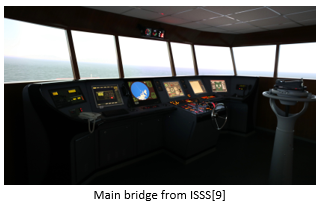
The Ship Navigation and Manoeuvring Module enables the training of watch officers, shipmasters, and pilots operating on commercial or fishing vessels with displacements starting from 500 tons deadweight (tdw), per the provisions of IMO STCW 78/95, as stipulated in course models 7.01 and 7.03.
The ship navigation and manoeuvring simulator consists of 11 navigation decks and a briefing room, where 11 ships can be simulated simultaneously. The navigation decks contain all equipment specific to a SOLAS vessel.
The simulator was periodically upgraded, both in hardware and software, to maintain compatibility with technological development and STCW requirements. The evolving nature of maritime warfare, as highlighted by the Russo-Ukrainian conflict, necessitates significant adaptations in naval training to address emergent operational requirements. These requirements include developing scenarios with contemporary threats (e.g., drifting mines, unmanned systems, GPS/communication jamming), enhancing simulator integration for concurrent tactical and navigational training, and implementing continuous four-hour watch schedules to ensure sustained operational readiness. Furthermore, joint exercises integrating trainees with active warship crews are crucial for fostering practical experience and interoperability. The integration of advanced systems, such as the War Automatic Identification System (WAIS), and comprehensive training on advanced sensor modelling, including material reflectivity and three-dimensional radar wave propagation, are also essential.
The ERS TechSim 9 Engine Room Simulation Module is used for electrical, technical, and engineering cadets and engine room watch officers. The simulator meets all the requirements imposed by the STCW 95 Code and Convention regarding the standards for training engine room personnel through IMO course models 2.07, 2.08, 7.02, and 7.04.
The Engine Room Simulator comprises an instructor station, the Engine Control Room, the Engine Room, the Emergency Generator Room, and a briefing room.

The simulator serves several key training functions. It helps to familiarise crews with engine compartments and supports their initial training. Crews also use it to practice standard operating procedures and how to conduct watch duties effectively in both normal and special conditions. Additionally, the simulator is used for advanced operational training, covering areas such as Engine Team Management, Crisis Management, and troubleshooting failures that occur during operation. Electrical technical officers and engineers, working with Naval Academy (RNA) instructors on curriculum updates, pinpointed several training improvements. Key suggestions include creating new scenarios for realistic threats (e.g., damage control from cyber-attacks, mines, or drones), implementing continuous 4-hour watch training, fostering joint exercises for students with warship crews, and ensuring remote training access for cadets at sea.
Within the Integrated Ship Steering Simulator, there is also a GMDSS maritime communications simulator, which enables students and trainees to train for the GOC (General Operator’s Certificate).
The GMDSS maritime communications simulator is installed on every navigation bridge of ISSS. The software provides a simulation of three different maritime communications equipment to familiarise the trainees with the diversity of on-board real life.
The training that is underway is related to: GMDSS equipment operation, GMDSS communication procedures and SAR procedures.

The navy and merchant officers specialised in communications, in collaboration with specialists from ANCOM (National Authority for Management and Regulation in Communications of Romania)[13] and teachers from RNA identified aspects that must be upgraded in training. The most important one is the use of integrated scenarios with a navigation simulator for updated, realistic threats. Another important aspect is the integration with military communications simulators and integrated communications systems. For the Search and Rescue scenarios in conflict regions, the GMDSS communications must be integrated with Allied Communications Procedures. For a state-of-the-art training, the equipment database must be updated with GMDSS equipment, as Iridium Satellite terminals.
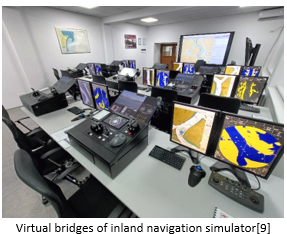
Inland Navigation Simulator
Another simulator for Navigation, Seamanship, and Watchkeeping is the inland navigation simulator. It is intended for professional training at a higher level of military river vessel crews, ship commanders or river pilots, as well as military and civilian students or master’s students. It respects the European ES-QIN standards adopted by CESNI and their training needs. It can simulate specific scenarios, even without the physical movement of the vessels, in an economical regime in terms of resources consumed. It has the possibility of resuming simulated exercises to acquire the knowledge and skills necessary for the management and manoeuvring of the vessel.
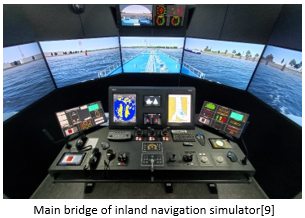
The configuration of the inland navigation simulator comprises an instructor station, eight student workstations (virtual decks), and a main navigation deck. This allows for a wide range of training options in inland vessel handling and navigation, as well as familiarisation with navigation radar and inland Electronic Chart Display and Information System (ECDIS).
Although the simulator has only been in use for about a year, river navigation specialists and instructors have already identified several areas for improvement.
They suggest, for instance, better integration of WAIS and Automatic Transmission Identification System (ATIS). There is also a need to create training scenarios featuring updated and realistic threats, such as drifting mines, drones, or situations with jammed GPS and communication systems. Further recommendations include linking the current simulator with a tactical simulator to enable combined practice of both tactical and navigational procedures. Additionally, they propose implementing 4-hour training shifts to cover day and night operations, and organising joint training exercises that involve both students and the crews of river warships.
Other STCW Simulators for Navy Officers
Before cadets can participate in training with integrated systems, they must have proper knowledge of the individual systems. To achieve this basic and focused training, the RNA applied a strategy to implement simulators that can be used as stand-alone systems or integrated into complex systems. An example is the Radar/ARPA (Automatic Radar Plotting Aid) Simulators. In this simulator, the cadets are trained in the use of RADAR for navigation, collision avoidance, and target tracking.
This type of training could be improved by creating scenarios for detecting and classifying threats, such as warships, drones, and drifting mines, implementing EW attack countermeasures (fake targets), and integrating with the LINK22 simulator (to be installed in the near future).
Another example is the ECDIS (Electronic Display and Information System) Simulator. It provides training to students/trainees at the level required for subsequent “ECDIS Type Specific Training” certification. An important aspect to note is that the ECDIS console also includes military-specific modules, specifically AML (Advanced Military Layers).
This simulator would benefit from further development to incorporate WECDIS (including its tactical grid) and from the use of training scenarios and case studies based on real-life accidents.[14]
Action Speed Tactical Trainer Proteus
For tactics, operations and strategy training, the RNA uses the ASTT (Action Speed Tactical Trainer) PROTEUS simulator. It is intended to familiarise military students with naval tactical procedures. It is also used to train the skills and abilities necessary for students to operate various sensors and weapon systems on board the ships. NATO standards are used for training the operations from the Combat Information Centre (C.I.C.).
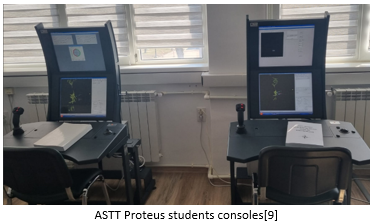
The simulator can accommodate up to 25 trainees simultaneously, typically divided into two teams. It can edit/create and simulate models of navy platforms, all kinds of sensors, weapons and communications systems. These models can be used as friend or foe entities.
Also, it is used to simulate different hydrometeorological situations for all types of warfare. At the end of the exercises, the simulator offers feedback on the military actions performed (kinematic or material losses).
The most challenging curriculum to improve is that of tactics, operations, and strategy. For the bachelor’s degree level, the training is focused on the tactical level. The tactical training is related to your combat system versus your enemy’s combat system. Due to the variety of equipment, it is challenging to establish a common tactical training among allies. Nevertheless, for basic training, NATO released unclassified and restricted tactical procedures. The unclassified procedures create a powerful tool for training cadets among allies. Combining a tactical simulator, such as ASTT, with NATO tactical procedures yields an efficient method for training future Navy officers. To further optimise tactical training effectiveness, several critical implementations are necessary. These include the advanced modelling of contemporary threats (such as unmanned systems/drones, drifting mines, and emerging Electronic Warfare techniques) and enhanced integration with navigation simulators to enable concurrent tactical and navigational procedure training. Additionally, the training regimen should incorporate continuous 4-hour watch schedules for around-the-clock operations and foster expanded joint exercises between cadets and NATO warship crews. Critically, future developments must also involve the integration of scenarios and operational lessons from the ongoing Russo-Ukrainian conflict, alongside the development and employment of simulated combat system models representative of those used by European Union (EU) and NATO member states.
Due to the variety of equipment, it is challenging to establish a common tactical training among allies.
Sting Ray Torpedo Simulator
For training in the domain of ASW, the RNA uses the STING RAY Torpedo simulator. It is a simulator produced by BAE Systems from Great Britain and is intended for individual and collective training of operators in the field of STING RAY torpedo launches, and personnel who manage the CIC on ships, both military personnel and ASW officers.
The product covers the requirements of a STING RAY torpedo launch driving simulator and can also be used for personnel evaluation. The simulator is based on the OLS (Off-Line Simulation) program, a software developed using the experience and data provided by the BAE Systems Real-Time Simulator. OLS (Off-Line Simulation) is a program that simulates attacks with Sting Ray torpedoes against submarines. OLS can simulate different situations, targets, and characteristics of the weapons, all of which are edited and incorporated into the simulation process. It also contains a Sting Ray torpedo mode 2 – sectioned for didactic purposes.

To optimise the simulator for advanced training, particularly in anti-submarine warfare (ASW), several enhancements and applications should be considered. Its use should be extended to personnel operating naval helicopters for ASW missions. Joint training programs pairing experienced ASW officers with students could also offer significant value. Furthermore, incorporating authentic data from launched torpedoes into simulations would greatly improve realism. Finally, integrating the simulator with existing sonar laboratories and underwater acoustic propagation simulators would substantially augment its overall training capability.
Complex of shooting simulators for infantry and artillery
The RNA utilises a complex of shooting simulators for infantry and artillery for physical and military training. This complex of simulators is used for training Romanian Navy students and national partners, but also for NATO and European Union members’ students. Its mission is to conduct real training, using simulated ammunition and real weapons, in a simulated shooting environment. The simulators combine real equipment with simulated enemies and scenarios.
Shooting weapon simulators are constructed based on combat weapons, with the option of firing live ammunition permanently removed, adapted for simulated, virtual shooting, making it safe for exploitation.
The weapon simulators retain all functional and manual properties specific to the individual real combat weapon type, such as loading, reloading, safety, fire type switches, the option of individual firing, short series and series firing.
The weapon simulators generate electronic (virtual) shots within the computer system, simulating recoil caused by the movement of the weapon mechanisms through a high-pressure (50 bar) pneumatic system.
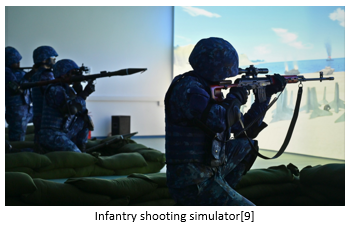
The complex of shooting simulators is constructed of:
- Infantry shooting simulator – with a projected area of 12×2.5 m, divided into a maximum of six individual and independent projections.
Artillery shooting simulator – with a projected area of 12×3 m, realised from 3 screens mounted to form half of a hexagon to offer a projected image of 120°.The identification of the hitting point is realised by a laser point displayed by a laser permanently installed on the simulator and detected on the large screen by an infrared camera.
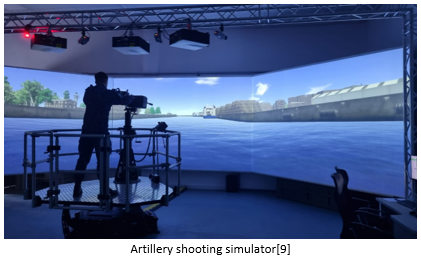
Every shot is accurately identified and assigned to the relevant weapon for each shooting station and each person in training. In this way, the history of training and performance of the cadets is preserved and can be further utilised for improvement.
For realistic training, the simulators accurately reflect the ballistics of projectiles in virtual space, based on the ballistics of actual projectiles corresponding to the weapon types (projectile muzzle velocity) and the correct ammunition (specifically, projectile weight), taking into account the physical parameters in the virtual world. These include temperature, atmospheric pressure, air humidity and wind. These aspects are very important for a solid initial training of cadets.
- Technical description of infantry simulator-modified weapons
The simulator was developed based on an actual combat firearm. The firearm has been stripped of the ability to shoot live rounds. Its looks, construction, preparation for shooting, and the shooting itself do not differ significantly from the actual firearm.
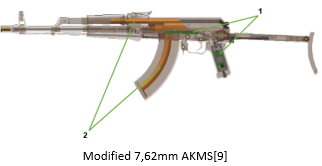
In addition to the mechanical part based on the actual rifle, the simulator includes:
‒ an electronics unit with a magazine recognition module, shooting sensor, MKB cable socket and laser mount with a laser module,
‒ a simulator pneumatic reload system assembly with a bolt carrier, valve and gas tank.
- Technical description of artillery-modified machine gun
This simulator was also developed based on a real weapon.
In addition to the mechanical part based on the actual machine gun, the simulator includes:
‒ an electronic unit (1) with the round sensor, reload system sensor, chamber cover lock sensor, laser module, shot sensor, and electronics assembly.
‒ a simulator pneumatic reload system assembly (2) with a solenoid valve actuator, flexible pressure hose and gas container
The set includes a mock-up of 12.7 mm rounds (10 pcs on a belt).
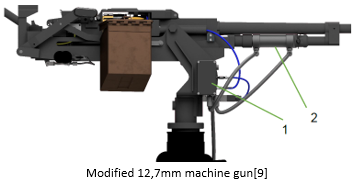
In conclusion, the emergence of novel threats, such as UAS, and the re-emergence of insidious dangers, including drifting mines, mandate a proactive and continuous evolution in naval training doctrine and technology. By upgrading shooting simulators with realistic and challenging scenarios, accurate threat and environmental modelling, integrated tactical procedures, and comprehensive performance assessment tools, naval forces can ensure their personnel are robustly prepared to confront these contemporary maritime security challenges. Ongoing investment and innovation in simulator capabilities will be paramount in maintaining a decisive operational edge in an increasingly complex and contested global maritime environment.
Feedback from Training in ASST Proteus Simulator
This study, conducted at the end of the fall semester of 2024-25, involved twenty student participants with baseline tactical knowledge to assess the impact of tactical simulator training. The research utilised a pre- and post-training observational design based on subjective feedback. Participants completed three structured sessions with the ASTT Proteus tactical simulator, each approximately 90 minutes long and increasing in complexity, followed by a debriefing that included gameplay review and discussion of strategies. Qualitative data on perceived improvements in skill and knowledge were collected through open-ended questionnaires and group discussions, particularly at the final session. This feedback was analysed for recurring themes and to estimate percentage improvements in key skill areas.
The results indicated a positive impact on skill development and tactical knowledge. Participants reported significant perceived improvements: 25-30% in situational awareness, 30-40% in communication under pressure, 20-25% in teamwork, and 30-35% in decision-making speed. A general tactical knowledge improvement of 20-30% and a 20-25% enhancement in scenario analysis were also noted. Importantly, all students who were previously unaware of their weaknesses gained a better understanding of them. The simulator’s realistic environment and structured debriefings were seen as facilitating effective learning.
A general tactical knowledge improvement of 20-30% and a 20-25% enhancement in scenario analysis were noted.
The study acknowledged limitations, including its reliance on subjective self-reporting, the qualitative nature of improvement estimations, the absence of a control group, and the lack of objective skill measurements. Student feedback also suggested potential simulator enhancements regarding AI behaviour, environmental detail, and user interface.
In summary, the tactical simulator training effectively contributed to the development of critical tactical skills and knowledge, highlighting its potential as a valuable component in comprehensive training programs.
Conclusions
This article demonstrates the pivotal role of advanced simulators in modern naval education. These tools transcend traditional methods, providing immersive and risk-free environments for complex tactical training. By replicating real-world scenarios, simulators enhance decision-making, teamwork, and technical proficiency. The article emphasises that integrating these technologies is crucial for preparing officers to navigate the increasingly sophisticated challenges of maritime operations. Ultimately, the adoption of state-of-the-art simulators is crucial for cultivating a highly skilled and adaptable naval force, thereby ensuring operational readiness and a strategic advantage. The study results emphasised the importance of simulation-based training and showed immediate outcomes for skills and knowledge.
By replicating real-world scenarios, simulators enhance decision-making, teamwork, and technical proficiency.
Several generic improvements for training were identified in this study. These are: creating scenarios with updated realistic threats such as: drifting mines, drones, jammed GPS and comms; integration between different types of simulators; implementation of 4-hour shifts training during the day and night; and joint training between warships’ crew and students and creating a network of simulators for EU and NATO member states.
Ovidiu Cristea, Eng, PhD in EE, associate professor, head of the department of Navy tactics and combat systems. Publications: https://www.researchgate.net/profile/Ovidiu_Cristea2, https://scholar.google.com/citations?user=VBaKQWsAAAAJ&hl=en, https://orcid.org/0000-0002-4215-6578, https://www.webofscience.com/wos/author/record/GWV-4088-2022
Nicolae-Silviu Popa, PhD, attendance in EE, head of the laboratories and simulators of Navy tactics and combat systems department
Catalin Popa, PhD in Economics, associate professor, vice-rector for programs and international relations
The views contained in this article are the authors’ alone and do not represent the views of the Romanian Naval Academy.
[1] United States Naval Academy, “Academics,” accessed May 26, 2025, https://www.usna.edu/Academics/index.php.
[2] Naval Education and Training Command (NETC), “Enclosure (1) 2025 Officer Professional Core Competencies (PCC) Manual,” accessed May 26, 2025, https://www.netc.navy.mil/Portals/46/NSTC/competencies.
[3] Royal Navy, “Training at Britannia Royal Naval College,” accessed May 26, 2025, https://www.royalnavy.mod.uk/careers/…/training-at-britannia-royal-naval-college.
[4] Andrew S. Erickson, “War Without Surprises: Education for Command in the PLA Navy,” May 2025, accessed May 26, 2025, https://www.andrewerickson.com/2025/05/war-without-surprises-education-for-command-in-the-pla-navy/.
[5] Military School Directory, “Russia – Fleet Admiral Nikolai Kuznetsov Naval Academy,” accessed May 26, 2025, https://militaryschooldirectory.com/russia-fleet-admiral-nikolai-kuznetsov-naval-academy/.
[6] Federation of American Scientists (FAS), “Japan Maritime Self-Defence Force (JMSDF),” Intelligence Resource Program, accessed May 26, 2025, https://irp.fas.org/world/japan/jmsdf.htm.
[7] École Navale, “Homepage,” accessed May 26, 2025, https://www.ecole-navale.fr/.
[8] U.S. Naval Institute, “A Comparison of U.S. Navy and Royal Navy Officer Training,” accessed May 24, 2025, https://www.usni.org/magazines/proceedings/2018/march/comparison-us-navy-and-royal-navy-officer-training.
[9] Romanian Naval Academy, “Romanian Naval Academy’s Faculties infrastructure presentation,” accessed May 27, 2025, https://www.anmb.ro/…/simulatoare/prezentare_generala.html.
[10] European Skills, Competences, Qualifications and Occupations (ESCO), “Qualifications,” accessed May 23, 2025, http://data.europa.eu/esco/occupation/262f21a3-ae78-46f4-a5f9-5a1f502caa90.
[11] European Skills, Competences, Qualifications and Occupations (ESCO), “About ESCO,” accessed May 23, 2025, https://esco.ec.europa.eu/en/about-esco.
[12] International Maritime Organization, “International Convention on Standards of Training, Certification and Watchkeeping for Seafarers (STCW),” accessed May 23, 2025, https://www.imo.org/en/ourwork/humanelement/pages/stcw-conv-link.aspx.
[13] The National Authority for Management and Regulation in Communications, “Radiocommunications – Maritime services,” accessed May 24, 2025, https://www.ancom.ro/en/radiocommunications_2906.
[14] MarineTraffic, “Maritime news – Accidents,” accessed May 24, 2025, https://www.marinetraffic.com/en/maritime-news/14/Accidents.


